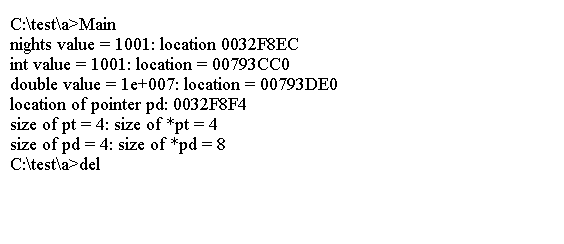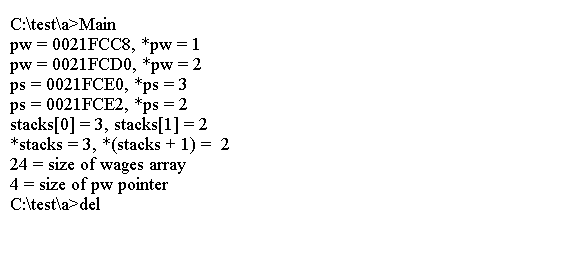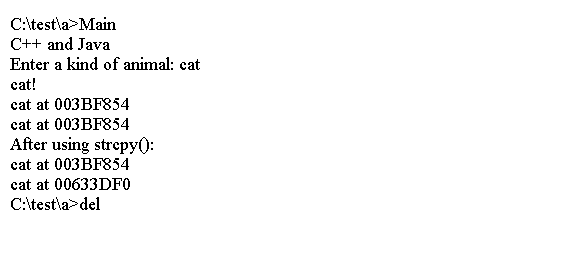C++ 指针
学习C++ - C++指针
以下代码使用&运算符来查找地址。
#include <iostream>
using namespace std;
int main()
{
int donuts = 6;
double cups = 4.5;
cout << "donuts value = " << donuts;
cout << " and donuts address = " << &donuts << endl;
cout << "cups value = " << cups;
cout << " and cups address = " << &cups << endl;
return 0;
}
上面的代码生成以下结果。

例子
指针的名称代表位置。
应用*运算符在该位置产生值。
#include <iostream>
int main()
{
using namespace std;
int updates = 6; // declare a variable
int * p_updates; // declare pointer to an int
p_updates = &updates; // assign address of int to pointer
// express values two ways
cout << "Values: updates = " << updates;
cout << ", *p_updates = " << *p_updates << endl;
// express address two ways
cout << "Addresses: &updates = " << &updates;
cout << ", p_updates = " << p_updates << endl;
// use pointer to change value
*p_updates = *p_updates + 1;
cout << "Now updates = " << updates << endl;
return 0;
}
上面的代码生成以下结果。

声明和初始化指针
指针声明必须指定指针指向什么类型的数据。
例如,前面的例子有这个声明:
int * p_updates; 这表示组合* p_updates是int类型。
p_updates变量本身必须是一个指针。
p_updates指向类型int。
p_updates的类型是指向int的指针,更简明地,int *。
p_updates是一个指针(地址),*p_updates是一个int而不是一个指针。
int*是一个类型,指向int。
以下声明创建一个指针(p1)和一个普通的int(p2):
int* p1, p2; 每个指针变量名称需要一个*。
以下代码演示如何初始化指向地址的指针。
#include <iostream>
using namespace std;
int main()
{
int higgens = 5;
int * pt = &higgens;
cout << "Value of higgens = " << higgens
<< "; Address of higgens = " << &higgens << endl;
cout << "Value of *pt = " << *pt
<< "; Value of pt = " << pt << endl;
return 0;
}
上面的代码生成以下结果。

用新的分配内存
这是一种用于获取和分配单个数据对象的内存的一般形式,它可以是一个结构以及一个基本类型,它是:
typeName * pointer_name = new typeName; 您使用数据类型两次:一次指定所请求的内存种类,一次声明一个合适的指针。
#include <iostream>
using namespace std;
int main()
{
int nights = 1001;
int * pt = new int; // allocate space for an int
*pt = 1001; // store a value there
cout << "nights value = ";
cout << nights << ": location " << &nights << endl;
cout << "int ";
cout << "value = " << *pt << ": location = " << pt << endl;
double * pd = new double; // allocate space for a double
*pd = 10000001.0; // store a double there
cout << "double ";
cout << "value = " << *pd << ": location = " << pd << endl;
cout << "location of pointer pd: " << &pd << endl;
cout << "size of pt = " << sizeof(pt);
cout << ": size of *pt = " << sizeof(*pt) << endl;
cout << "size of pd = " << sizeof pd;
cout << ": size of *pd = " << sizeof(*pd) << endl;
return 0;
}
上面的代码生成以下结果。

通过删除释放内存
删除操作符使您能够将内存返回到内存池。
你可以使用delete来跟踪一个指向最初分配给新的内存块的指针:
int * ps = new int; // allocate memory with new . . . // use the memory delete ps; // free memory with delete when done
这将删除ps点的内存。
它不会删除指针ps本身。
您可以重用ps来指向另一个新的分配。
你不应该尝试释放先前释放的内存块。
使用new创建动态数组
在C++中创建动态数组很容易;你要告诉新数组元素的类型和你想要的元素数目。
语法要求您使用括号中的元素数量来遵循类型名称。
例如,如果你需要一个10 int的数组,你可以使用:
int*psome = new int[10]; //获取10个int的块
new运算符返回块的第一个元素的地址。
在此示例中,该值分配给指针psome。
使用新增括号创建数组时,需要在释放数组时使用替代形式的delete:
delete [] psome; // free a dynamic array
括号告诉C++释放整个数组,而不仅仅是指针指向的元素。
这里举个例子:
int * pt = new int; short * ps = new short [500]; delete [] pt; // effect is undefined, don"t do it delete ps; // effect is undefined, don"t do it
不要使用delete来释放新的没有分配的内存。
不要使用delete来连续释放同一块内存两次。
如果您使用new []来分配数组,请使用delete []。
如果您使用新的分配单个实体,请使用delete(无括号)。
分配和分配数组的内存的一般形式是:
type_name * pointer_name = new type_name [num_elements];
例子
#include <iostream>
using namespace std;
int main() {
double * p3 = new double [3]; // space for 3 doubles
p3[0] = 0.2; // treat p3 like an array name
p3[1] = 0.5;
p3[2] = 0.8;
cout << "p3[1] is " << p3[1] << ".\n";
p3 = p3 + 1; // increment the pointer
cout << "Now p3[0] is " << p3[0] << " and ";
cout << "p3[1] is " << p3[1] << ".\n";
p3 = p3 - 1; // point back to beginning
delete [] p3; // free the memory
return 0;
}
上面的代码生成以下结果。

指针,数组和指针算术
C++将数组名解释为地址。
#include <iostream>
using namespace std;
int main() {
double wages[3] = {1.0, 2.0, 3.0};
short stacks[3] = {3, 2, 1};
// two ways to get the address of an array
double * pw = wages; // name of an array = address
short * ps = &stacks[0]; // or use address operator
// with array element
cout << "pw = " << pw << ", *pw = " << *pw << endl;
pw = pw + 1;
//add 1 to the pw pointer
cout << "pw = " << pw << ", *pw = " << *pw << "\n\n";
cout << "ps = " << ps << ", *ps = " << *ps << endl;
ps = ps + 1;
//add 1 to the ps pointer
cout << "ps = " << ps << ", *ps = " << *ps << "\n\n";
//access two elements with array notation
cout << "stacks[0] = " << stacks[0]
<< ", stacks[1] = " << stacks[1] << endl;
//access two elements with pointer notation
cout << "*stacks = " << *stacks
<< ", *(stacks + 1) = " << *(stacks + 1) << endl;
cout << sizeof(wages) << " = size of wages array\n";
cout << sizeof(pw) << " = size of pw pointer\n";
return 0;
}
上面的代码生成以下结果。

指针和字符串
数组和指针之间的特殊关系扩展到C风格的字符串。请考虑以下代码:
char flower[10] = "rose"; cout << flower << "s are red\n";
数组的名称是其第一个元素的地址。
以下代码使用字符串库中的两个函数。
strlen()函数返回字符串的长度。
strcpy()函数将字符串从一个位置复制到另一个位置。
#include <iostream>
#include <cstring> // declare strlen(), strcpy()
using namespace std;
int main() {
char animal[20] = "C++"; // animal holds bear
const char * bird = "Java"; // bird holds address of string
char * ps; // uninitialized
cout << animal << " and "; // display bear
cout << bird << "\n"; // display wren
cout << "Enter a kind of animal: ";
cin >> animal; // ok if input < 20 chars
ps = animal; // set ps to point to string
cout << ps << "!\n"; // ok, same as using animal
//Before using strcpy()
cout << animal << " at " << (int *) animal << endl;
cout << ps << " at " << (int *) ps << endl;
ps = new char[strlen(animal) + 1]; // get new storage
strcpy(ps, animal); // copy string to new storage
cout << "After using strcpy():\n";
cout << animal << " at " << (int *) animal << endl;
cout << ps << " at " << (int *) ps << endl;
delete [] ps;
return 0;
}
上面的代码生成以下结果。

例3
以下代码使用new创建一个未命名的结构,并演示访问结构成员的两个指针符号。
#include <iostream>
using namespace std;
struct Product // structure definition
{
char name[20];
float volume;
double price;
};
int main() {
Product * ps = new Product; // allot memory for structure
cout << "Enter name of Product item: ";
cin.get(ps->name, 20); // method 1 for member access
cout << "Enter volume in cubic feet: ";
cin >> (*ps).volume; // method 2 for member access
cout << "Enter price: $";
cin >> ps->price;
cout << "Name: " << (*ps).name << endl; // method 2
cout << "Volume: " << ps->volume << " cubic feet\n"; // method 1
cout << "Price: $" << ps->price << endl; // method 1
delete ps; // free memory used by structure
return 0;
}
上面的代码生成以下结果。

例4
以下代码显示如何使用delete操作符。
#include <iostream>
#include <cstring> // or string.h
using namespace std;
char * getname(void); // function prototype
int main() {
char * name; // create pointer but no storage
name = getname(); // assign address of string to name
cout << name << " at " << (int *) name << "\n";
delete [] name; // memory freed
name = getname(); // reuse freed memory
cout << name << " at " << (int *) name << "\n";
delete [] name; // memory freed again
return 0;
}
char * getname() // return pointer to new string
{
char temp[80]; // temporary storage
cout << "Enter last name: ";
cin >> temp;
char * pn = new char[strlen(temp) + 1];
strcpy(pn, temp); // copy string into smaller space
return pn; // temp lost when function ends
}
上面的代码生成以下结果。





更多建议: